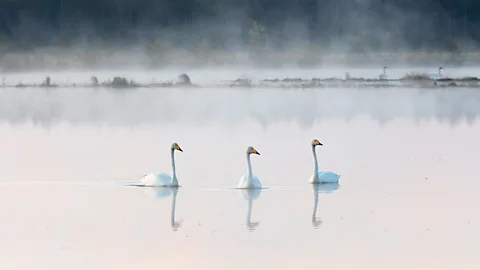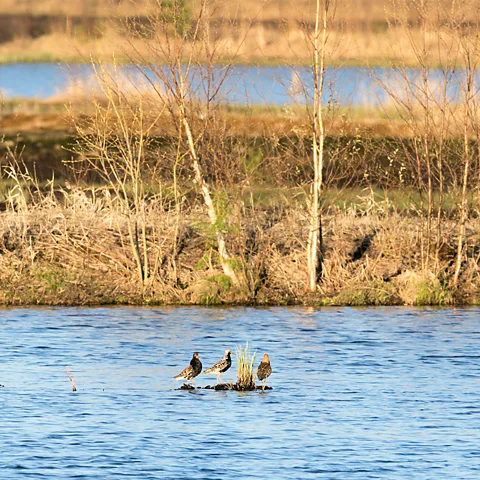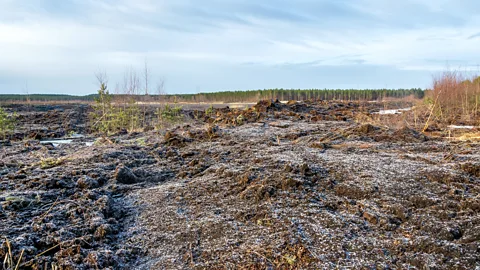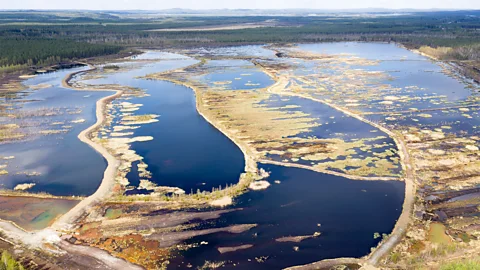 Mika Henkalina
Mika HenkalinaFinland’s Linnunsuo lagoon used to be a barren “moonscape”. A local fishing community has turned it into a biodiversity haven and an important carbon sink.
On a piece of land near Finland’s eastern border, life exists where it didn’t exist before.
Shallow waters ripple along a beach of grass and rushes, where endangered species of ducks nest on the ground. Small herds of waders gather, their thin legs moving through the silvery water, beaks pounding the surface.
This is the Linnunsuo Lagoon, a patch of land that hasn’t always been full of life and rustling. Only 13 years ago, it was a brown and barren “moonscape,” says Tro Mustonen, a local fisherman and co-founder of Finnish environmental nonprofit Snowchange.
The Finnish bioenergy company Vapo (now Neova) drained the land in the 1980s so it could mine the energy-rich peat underwater. For more than two decades, it mined the area, leaving a scarred brown landscape Nothing could grow. (Vapo did not respond to the BBC’s request for comment.)
But Mastonen and the rest of the team at Snowchange have turned this ruined peatland into what it is today.
Mastonen, who is also a climate scientist at the UN’s Intergovernmental Panel on Climate Change (IPCC), describes peatland’s role in the climate crisis as “almost like the planet’s second lung”.
Although peatlands release methane, they also remove carbon dioxide (CO2) and in the long term have a Cooling effect On this planet they can store around three times It has more carbon than forests and is estimated to store 15-30% carbon of the world’s soil, but when peat lands are extracted, Instead of storing carbon, they emit it. Every year, the damaged peats release Almost 6 percent of all human-caused carbon emissions
 Mika Henkalina
Mika HenkalinaFor Mastonen, it is obvious that carbon sequestration efforts should be focused on peatlands. “When with IPCC Sixth Assessment Reportwe’ve been making statements that there’s a short window of about seven or eight years to think, “How can we increase carbon storage?” “And it turns out that peatland is one of the fastest and most cost-effective ecosystems we can operate in.”
The Boreal region, including Finland, is one of the richest peat regions in the world. Finland isn’t a superpower at almost anything – except for heavy metal and Santa Claus – but one thing the Ice Age left us with was a landscape where one third Mastonen says that the country is Torbland.
That’s exactly what happened in Linnunsuo, a 1.1-square-kilometer (0.4-square-mile) tract of land in northern Karelia in eastern Finland. Peat mining began in the 1980s, disturbing the troubled soils. High levels of ferrous sulfate. “Those iron sulfate soils are very acidic,” Mostonen explains. They were exposed to oxygen for the first time in thousands of years and began to produce highly acidic waters when it rained or snow melted.
In 2010, local fishermen saw dead fish and seagulls floating in the river. sounded the alarm. Water quality assessment confirmed the cause – the peatland mine was what Mastonen calls “a severe event that was fatal to all life”.
 Antoine Scherer
Antoine SchererSnowchange was eventually able to buy Linnunsuo and with the support of and Guidance of local villagersbegan work to restore it to health in 2011.
“We’re trying to restore the function of nature. That’s it,” Mastonen says. And for a peat bog, the key to this capability is water.
So Mastonen and a small team of fishermen and other local villagers tried to restore the wetlands that were once there. “We learned from traditional knowledge that we need to bring those places back under water,” he says. They created dams and wetland pools that were built in interlocking units to allow water to flow from one to the other.
Their work was successful. Importantly, rewetting the ground has stopped its peat from breaking down Prevents harmful CO2 emissions. And the land that was once barren quickly filled with life.
Before this, living creatures were kept away except for crows and black cocks. But in 2013, only one year after the restoration of the wetland, 120 species of birds – including the threatened Northern Pintail and the vulnerable Great Spotted Eagle – have been recorded in the area. To date, about 205 species of birds have been observed, and there are as many of them 100,000 geese According to Snowchange, you visit at a time.
Mastonen says the Snowchange team’s camera traps show that wolverines visit the area and are attracted to Linnunsuo by the remains of dead birds. Bears believed to live in the nearby forest now wander into the wetlands as part of their extensive travels. And the deer pass by the ponds and feed on the young trees that surround the water.
A smaller, quieter life form is also back, portending good news for the future of desert lands: sphagnum mosses. This fluffy plant Produces peat As it decomposes, that over time increases Linnunsuo’s ability to store carbon.
Despite believing in the project, the Snowchange team didn’t expect to see a transformation of such speed and scale, says Kaiso Mastonen, co-founder and head of biodiversity at Snowchange and Tero’s wife. “[The area] It saved so many lives so quickly, and we still don’t know all the drivers and why it happened so quickly. Everyone was surprised.”
Kaiso Mostonen says what is clear is that the return of the invertebrates was the first step towards the recovery of the area. Larvae quickly appeared in pools of water, and the area was soon overrun with six-legged life that turned into a feast that turned the birds away.
 Mika Henkalina
Mika HenkalinaSnowchange aims to offer a new way of approaching conservation – one that puts agency in the hands of local people and respects those people’s existing relationships with the land.
“In every rural area in Europe, you have a camp that says, ‘Oh, the hippies are here — they’re going to destroy our land, our economy, our traditions,'” says Mastonen. And then you have the protectionists saying everything should be protected.”
Snowchange takes a “third way,” he says. Native and protected areas of the community (IPCAs) “They are areas where conservation is done through restoration and restoration, but local villagers re-own their sites.”
In this approach, Mastonen says, local knowledge is crucial – and recognized as such. In Linnunsuo, “the pollution and fish death events were detected by the fishermen, not by the government, or corporate oversight”.
Ecologist Maria Tengo leads research on the relationship between scientific and indigenous local knowledge at the Stockholm Resilience Center. He wasn’t involved in Linnunsuo’s project, it was him do research He says he’s also found that local and indigenous knowledge is “really powerful and really important.” “We’re no longer debating whether it’s important—it’s more about how it is.”
Kaiso Mostonen emphasizes that nature itself has also played an important role in Linonso’s remarkable recovery. He says: the story of this area is a reminder of “how much healing capacity nature has if we allow it, if we take that step back.”
The change of snow did not plant anything in the earth and prevent the return of life. “We try to stay away,” says Trou Mustonen simply. Exceptions to this are invasive species such as the North American mink and Russian raccoon dogs, which work with local hunters to trap and kill them.
The idea of rebuilding or restoring the Earth, Mastonen says, implies going back, turning back the clock – but it’s not. All this is a mistake. There is no going back to anything. In fact, it is better to call these new ecosystems. We are in the snow belt in the north, and this Faster heating From anywhere else, therefore, this century is very different in dynamics from anything we have experienced in the past thousands of years.”
 Kari Koskla
Kari KosklaThe group of local people working to rebuild Linnunsuo was small, just 12 people from a village of 300 people. But after Linnunsuo’s success, Snowchange took over. 550 square kilometers (212 square miles) of peatlands and woodlands in Finland, which are being restored and restored in close cooperation with local and indigenous communities.
Linnunsuo’s influence goes beyond this as well. Projects in Australia and England They extract from its findings. “It has become a source of great hope for many people that the return is real and tangible,” says Mostonen. “This is not Disney or a fictional story, but a real physical return that has now saved the lives of thousands of birds and cleaned up the waters.”
However, replicating these results is not straightforward. “Each river basin is unique, so while there are repeatable elements, it takes time to address these issues for each location … there is no one-size-fits-all solution,” Mastonen explains.
The unpredictability of the restoration work means there have also been limits to Linnunsuo’s success – Mastonen notes that hydrological return in the northern part of the site has been slower than expected. This, along with some recent hot summers, has affected plant growth in the area.
Mostonen says the project’s success is nonetheless reassuring. “The story of Linnunsuo is, of course, primarily about water production and real events,” he says. “But it’s also a symbol. And in these times, we need … new symbols that can stand the test of very heavy scientific research, have credibility, and continue to show that there is a way forward here. “
Tengö adds: To follow this path, we must remember that humans have a powerful and positive role in the future of the planet. Linnunsuo’s story is important, he says, because it shows that “we can move something in a different direction”.
“We are not monsters. People can be a positive force for nature.”
Follow us for more science, technology, environment and health from the BBC Facebook and X.
#People #positive #force #nature #Fishermen #restoring #Finlands #scarred #wastelands
